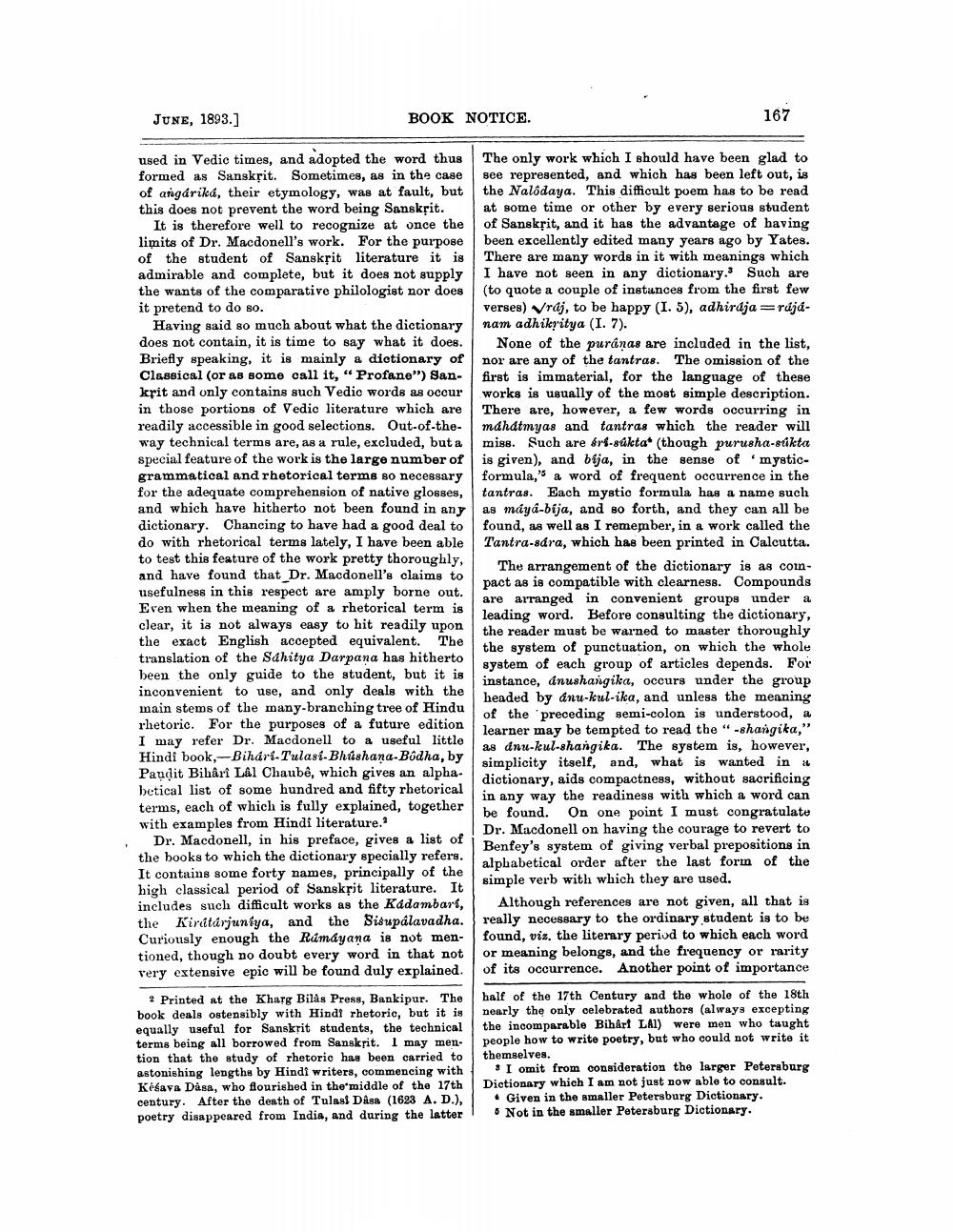________________
JUNE, 1893.]
BOOK NOTICE.
167
used in Vedio times, and adopted the word thus The only work which I should have been glad to formed as Sanskrit. Sometimes, as in the case see represented, and which has been left out, is of angárika, their etymology, was at fault, but the Nalodaya. This difficult poem has to be read this does not prevent the word being Sanskrit. at some time or other by every serious student
It is therefore well to recognize at once the of Sansksit, and it has the advantage of having limits of Dr. Macdonell's work. For the purpose been excellently edited many years ago by Yates. of the student of Sanskrit literature it is There are many words in it with meanings which admirable and complete, but it does not supply I have not seen in any dictionary. Such are the wants of the comparative philologist nor does (to quote a couple of instances from the first few it pretend to do so.
verses) Vrdj, to be happy (I. 5), adhirdja =rujdHaving said so much about what the dictionary nam adhikritya (I. 7). does not contain, it is time to say what it does. None of the puranas are included in the list, Briefly speaking, it is mainly a dictionary of nor are any of the tantras. The omission of the Classical (or as some call it, “ Profane") San- first is immaterial, for the language of these krit and only contains such Vedic words as occur works is usually of the most simple description. in those portions of Vedic literature which are There are, however, a few words occurring in readily accessible in good selections. Out-of-the- mahatmyas and tantras which the reader will way technical terms are, as a rule, excluded, butamiss. Such are brf-8ákta* (though purusha-stikta special feature of the work is the large number of is given), and bija, in the sense of 'mysticgrammatical and rhetorical terms so necessary formula,'' a word of frequent occurrence in the for the adequate comprehension of native glosses, tantras. Each mystic formula has a name such and which have hitherto not been found in any as maya-bija, and so forth, and they can all be dictionary. Chancing to have had a good deal to found, as well as I remember, in a work called the do with rhetorical terms lately, I have been able Tantra-sára, which has been printed in Calcutta. to test this feature of the work pretty thoroughly, and have found that_Dr. Macdonell's claims to
The arrangement of the dictionary is as con
pact as is compatible with clearness. Compounds usefulness in this respect are amply borne out.
are arranged in convenient groups under a Even when the meaning of a rhetorical term is clear, it is not always easy to hit readily upon
leading word. Before consulting the dictionary,
the reader must be warned to master thoroughly the exact English accepted equivalent. The
the system of punctuation, on which the whole translation of the Sahitya Darpana has hitherto
system of each group of articles depends. Foi been the only guide to the student, but it is
instance, anushangika, occurs under the group inconvenient to use, and only deals with the main stems of the many-branching tree of Hindu
headed by dnu-kul-ika, and unless the meaning
of the preceding semi-colon is understood, a rhetoric. For the purposes of a future edition
learner may be tempted to read the "-shangika," I may refer Dr. Macdonell to a useful little
as dnu-kul-shangika. The system is, however, Hindi book,-Bihari-Tulasi-Bhúshana-Bodha, by
simplicity itself, and, what is wanted in a Paudit Bihari Lal Chaube, which gives an alpha
dictionary, aids compactness, without sacrificing betical list of some hundred and fifty rhetorical
in any way the readiness with which a word can terms, each of which is fully explained, together
be found. On one point I must congratulato with examples from Hindi literature.
Dr. Macdonell on having the courage to revert to Dr. Macdonell, in his preface, gives a list of the books to which the dictionary specially refers.
Benfey's system of giving verbal prepositions in
alphabetical order after the last forin of the It contains some forty names, principally of the high classical period of Sanskrit literature. It
simple verb with which they are used. includes such difficult works as the Kadambari, Although references are not given, all that is the Kiritdrjuniya, and the Sisupalavadha. really necessary to the ordinary student is to be Curiously enough the Ramayana is not men- found, viz, the literary period to which each word tioned, though no doubt every word in that not or meaning belongs, and the frequency or rarity very extensive epic will be found duly explained of its occurrence. Another point of importance
? Printed at the Kharg Bilas Press, Bankipur. The half of the 17th Century and the whole of the 18th book deals ostensibly with Hindi rhetorie, but it is nearly the only celebrated authors (always excepting equally useful for Sanskrit students, the technical the incomparable Biharf LAI) were men who taught terms being all borrowed from Sanskrit. I may men- people how to write poetry, but who could not write it tion that the study of rhetoric has been carried to astonishing lengths by Hindi writers, commencing with I omit from consideration the larger Petersburg K ava Dasa, who flourished in the middle of the 17th | Dictionary which I am not just now able to consult. century. After the death of Tulasi Dasa (1623 A. D.), 1 • Given in the smaller Petersburg Dictionary. poetry disappeared from India, and during the latter Not in the smaller Petersburg Dictionary.




